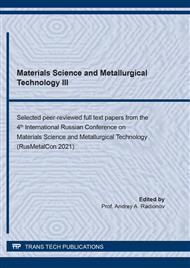[1]
S.A. Stepanova, Creation of a society focused on resource conservation. Initiative 3R, Recycling of Waste. 6 (2001) 3-4.
Google Scholar
[2]
E.E. Slick, USA Patent 1,086,789 (1914).
Google Scholar
[3]
D.B. McGahhey, USA Patent 4,982,591 (1991).
Google Scholar
[4]
S.I. Badyuk, A.I. Leshchenko, The preparation of high-quality profiles rolling of worn rails, Processing Materials by Pressure. 4 (2010) 162-167.
Google Scholar
[5]
G.K. Rozhkov, S.A. Levandovsky, S.Yu. Sarancha, A.B. Moller, D.I. Kinzin, O.N. Tulupov, Development of modern resource-saving technology for the production of reinforcing bars and grinding balls, Modeling and Development of Metal Processing Processes by Pressure. 3 (2019) 18-22.
Google Scholar
[6]
Y.B. Bahtinov, About the feasibility of rolling worn rails in rolled sections, Production of Rolled Products. 7 (2000) 2-4.
Google Scholar
[7]
V.K. Smirnov, V.A. Shilov, A.M. Mikhaylenko, Technology of processing of railway rails for long products, Steel. 2 (1995) 46-48.
Google Scholar
[8]
S.P. Galkin, RF Patent 2,293,619 (2007).
Google Scholar
[9]
S. Dobatkin, S. Galkin, Y. Estrin, V. Serebryany, M. Diez, N. Martynenko, E. Lukyanova, V. Perezhogin, Grain refinement, texture, and mechanical properties of a magnesium alloy after radial-shear rolling, Journal of Alloys and Compounds. 774 (2019) 969-979.
DOI: 10.1016/j.jallcom.2018.09.065
Google Scholar
[10]
N.V. Lopatin, G.A. Salishchev, S.P. Galkin, Mathematical modeling of radial-shear rolling of the VT6 titanium alloy under conditions of formation of a globular structure, Russian Journal of Non-Ferrous Metals. 52 (2011) 442-447.
DOI: 10.3103/s1067821211050075
Google Scholar
[11]
T.K. Akopyan, A.S. Aleshchenko, N.A. Belov, S.P. Galkin, Effect of radial-shear rolling on the formation of structure and mechanical properties of Al-Ni and Al-Ca aluminum-matrix composite alloys of eutectic type, Physics of Metals and Metallography. 119 (2018) 241-250.
DOI: 10.1134/s0031918x18010039
Google Scholar
[12]
T.K. Akopyan, N.A. Belov, A.S. Aleshchenko, S.P. Galkin, Y.V. Gamin, M.V. Gorshenkov, V.V. Cheverikin, P.K. Shurkin, Formation of the gradient microstructure of a new Al alloy based on the Al-Zn-Mg-Fe-Ni system processed by radial-shear rolling, Materials Science and Engineering A: Structural Materials: Properties, Microstructure and Processing. 746 (2019) 134-144.
DOI: 10.1016/j.msea.2019.01.029
Google Scholar
[13]
A. Naizabekov, A. Arbuz, S. Lezhnev, E. Panin, I. Volokitina, The development and testing of a new method of qualitative analysis of the microstructure quality, for example of steel AISI 321 subjected to radial shear rolling, Physica Scripta. 94 (2019) 105702.
DOI: 10.1088/1402-4896/ab1e6e
Google Scholar
[14]
Y. Gamin, T. Akopyan, A. Koshmin, A. Dolbachev, A. Aleshchenko, S.P. Galkin, B.A. Romantsev, Investigation of the microstructure evolution and properties of A1050 aluminum alloy during radial-shear rolling using FEM analysis, International Journal of Advanced Manufacturing Technology. 108 (2020) 695-704.
DOI: 10.1007/s00170-020-05227-8
Google Scholar
[15]
A. Arbuz, A. Kawalek, K. Ozhmegov, H. Dyja, E. Panin, A. Lepsibayev, S. Sultanbekov, R. Shamenova, Using of radial-shear rolling to improve the structure and radiation resistance of zirconium-based alloys, Materials. 13 (2020) 4306.
DOI: 10.3390/ma13194306
Google Scholar
[16]
N.A. Bogatov, RF Patent 2,356,718 (2009).
Google Scholar
[17]
S.P. Galkin, B.A. Romantsev, Innovative technology of recycling of sucker rods with the use of technology and Ministrov radial-shear rolling conditions ocher mashinostroitelnyi plant,, Engineering practice. 9 (2014) 58-61.
Google Scholar
[18]
E.A. Osachuk, Repair of sucker rods on the principle of hot radial-displacement and screw rolling, Engineering practice. 1-2 (2017) 17-23.
Google Scholar
[19]
V.V. Grevtseva, S.P. Galkin, Experimental testing of the technology of repeated use of railway axes with the use of radial-shear rolling, 72nd days of science of students of NUST MISIS. (2017) 123-126.
Google Scholar
[20]
S.P. Galkin, E.A. Kharitonov, Reversible radial-shear rolling. The nature, opportunities, advantages, Titanium. 1 (2003) 39-45.
Google Scholar


